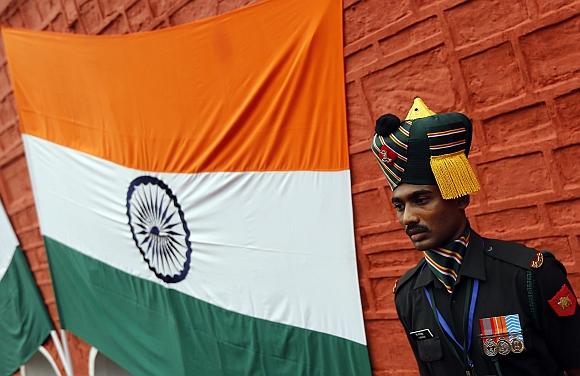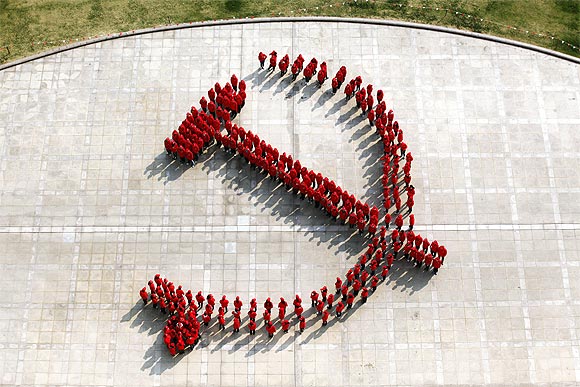
While we concentrate on the long-term through building military strength we cannot afford to ignore the instant and immediate. It is well within Indian capability to deal with this threat but for that we need clear thinking and resolute action -- not ‘Gandhigiri’, says Colonel (retd) Anil Athale.
As India celebrates its 67th birthday, incidentally coinciding with this author’s age, it will be an understatement to say that change is in the offing. Certainly the current PM is not likely to unfurl the tricolour next year, but the coming year presages more than mere political change. The coming 12 months are likely to see major challenges to the national security. While we must certainly celebrate our Independence Day yet at the same time the nation must also reflect on the dangers lurking ahead.
Recent happenings on the China and Pakistan border, where two aggressive neighbours have been resorting to pin-pricks are a cause for concern. But even more importantly, these happenings show up fundamental Indian weaknesses. As the Americans withdraw from Afghanistan next year, these pin-pricks have potential to cause gaping wounds to the nation.
Let us take Pakistan first. This country was formed as ‘homeland for the Muslims of the subcontinent’ and had basis in religious separatism. Contrary to the expectations of many peaceniks, that country has never given up its claims on parts of India in Kashmir or its irrational dream of flying its flag from Red Fort in New Delhi. The Cold War provided ‘steroids’ in form of Western military aid and diplomatic support to keep these illusions alive.
Many of us, including this author, thought that the end of Cold War would bring rationality in western approach to the sub-continent and the game of creating parity would end. In April 2000 when this author and late Lieutenant General Eric Vas (founding members of the Pune-based Indian Initiative for Peace, Arms-control & Disarmament) were on a lecture tour of US/Canada, we interacted with Washington-based think tanks.
...

We were told that the West was determined to ‘make’ India a military great power. The obvious rationale was to balance emerging China. A few years later, Condoleezza Rice, the national security advisor to President George Bush, made a public pledge on similar lines. The civil nuclear deal pushed by the US under President Bush was indeed a game changer. It ended India’s ‘pariah’ status since Pokhran I in 1974. However, the Indians under a dysfunctional government failed to act vigorously on this and Indian military capability continues to languish. It is futile to blame others for our own failing.
At the very moment, when the Americans were assuring Indo-US partnership (in April 2000) they were also selling 80 F-16 fighters to the United Arab Emirates (worth $6.4 billion). For those un-initiated in geo-politics, the UAE barely has air space to fly half of these aircraft. It is also noteworthy that their air force is trained and manned by Pakistan.
If history is any guide, then India must assume that this considerable air power is available to Pakistan in time of crisis. In 1965, at the height of Indo-Pakistan war, the Iranian and Jordanian air force lent their F-86 Sabre jets to Pakistan. Before the usual suspects begin to accuse this author of being concerned with history, let me quote the latest.
On August 2, 2013, the US intimated US Congress its intention to sell 145 light weight M-777 howitzers to India. The ultra light weight guns are being extensively used in Afghanistan and are a great force multiplier since these can be air lifted by helicopters. This is a particularly important characteristic for mountain fighting. But lo and behold, the US is also selling an unspecified quantity of the same guns to Saudi Arabia! Saudi Arabia has no mountains and the obvious destination for these guns is our western neighbour.
These two examples go to show that the old American policy of Indo-Pakistan parity and hyphenation is very much alive and kicking in short term at least.
...

As the Americans approach 2014 withdrawal from Afghanistan they will face a major dilemma as far as heavy equipment is concerned. The cost of carting all that 11,000 kms away to Centcom bases in the US may be greater than the value of that equipment. The US may well decide to ‘gift’ it to Pakistan, as another carrot to secure Pakistan help in orderly withdrawal. It may also decide to leave it for the Afghan forces. In that case as well, Pakistan is ready to help the Taliban take over Afghanistan (like in 1992 after Soviet withdrawal). In either eventuality, a major military accrual to Pakistan conventional strength is on cards.
What India faces in the West is not just Pakistan but a combination of Arab petro-dollars fuelled economic power backed by American armaments. The short-term geo-strategic compulsions faced by the US thus end up hurting Indian interests. In all this unfolding drama, China will play a ‘spoiler’ against India by keeping the border alive and forcing India to fight on two fronts.
At the root of all the problems we will confront in the coming year is the flawed Indian strategic doctrine of ‘reactive’ strategy. It needs to be remembered that when Pakistan sent infiltrators in J&K in 1965, India not only took action to eliminate them but also crossed the LoC and captured Pakistani posts in Haji Pir pass and Tithwal sector (the dominating Gitian feature).
On April 28, 1965, in wake of Pakistani adventure in Kutch, then prime minister Lal Bhadur Shastri warned Pakistan that India will retaliate at time and place of our own choosing. In this he was merely reiterating an earlier warning given by Pandit Jawaharlal Nehru in 1960s during the Ferozpur crisis. On September 6, 1965 we implemented that threat and Indian forces marched into Pakistan in the direction of Lahore.
...

Much water has flowed down the Ravi since then. Both the countries are a declared nuclear power. It is clearly understood in the world that while nuclear weapons do provide a ‘shield’ for defence, it also imposes constraints on conflict at lower levels due to fear of escalation. It is here that India with its bogus nuclear doctrine of ‘minimum deterrence’ and unilateral no first use pledge, has neutralised its retaliatory capability.
The Delhi-based armchair strategists de-linked the nuclear weapons from overall national security strategy. We have had a tragic-comic situation of nuclear scientists making pronouncements on defence strategy! It is like the Awadi tank factory manager deciding on the employment of ‘Vijayant’ tanks!
Deterrent or war prevention through armed strength is a combination of ‘capability’ plus ‘credibility’. India lacks credibility due to inaction in face of provocations. Contrary to the bogus logic of peaceniks, this inaction and loss of credibility can lead to failure of deterrence and a catastrophic nuclear war.
India is suffering and will continue to suffer due to the fact that instead of ‘flexible response’ we have a compartmentalised approach to threats of national security. Our weakness on China and Pakistan border stems from this basic strategic weakness of being unable to link the various levels of threats with national power.
While we concentrate on the long-term through building military strength we cannot afford to ignore the instant and immediate. It is well within Indian capability to deal with this threat but for that we need clear thinking and resolute action -- not ‘Gandhigiri’!
...